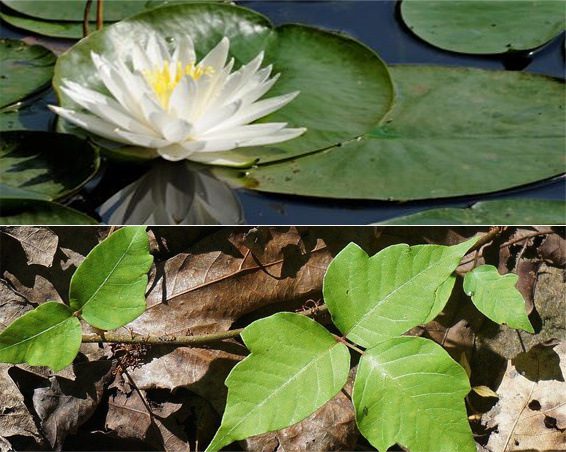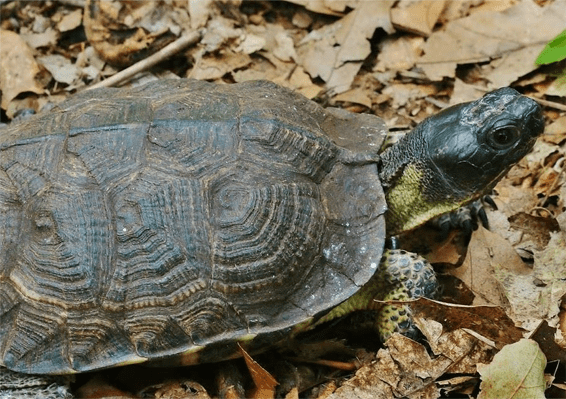
Below are frequently asked questions about local wildlife. For more information, you’re welcome to visit the library in the visitor center at the Tenafly Nature Center or contact us.


Contact the Rutgers Cooperative Extension of Bergen County (RCE). Their Master Gardener volunteers operate a Garden Helpline (April – September) and provide guidance on integrated pest-management for homeowners.
Horticulture Consultant
201-336-6788
Master Gardener Helpline
201-336-6783 or 201-336-6784
- Wash the area with soap and cool water as soon as possible.
- To ease itching: apply cool, damp cotton cloths.
- If you have severe reaction (swelling eyes, blistering), see a physician immediately.
- Note: The plant’s oily irritant (urushiol) exists even on dead or dormant parts, and exposure can trigger a rash in 3 out of 4 people.
- Rash may last 3–5 weeks if untreated.
Wildlife is best left in the care of its mother. The Tenafly Nature Center does not rehabilitate orphaned or injured birds. Please follow TNC’s Injured & Orphaned Birds guidance to determine if the bird is truly orphaned.
Possible reasons and solutions:
- The bird may be responding to insects inside your walls, eliminating the insect problem may help.
- It may be “drumming” to mark territory; siding or other surfaces can amplify the sound.
- Try these deterrents:
- Wait a week, the bird may move on.
- Install reflective bird-flash tape.
- Place a plastic owl nearby.
- Use “scare‐eye” balloons (inflatable, weather-resistant vinyl balloons that are about 15 to 16 inches in diameter when inflated, designed to look like predators with large, reflective eyes) to frighten the bird. DO NOT ATTEMPT WITH PARTY BALLOONS
Often caused by birds seeing their reflection (thinking it’s a rival). Solutions:
- Break the reflection: add shapes, streamers, hang a silhouette of a hawk.
- Cover the outside of the window for a few days if necessary.
- Additional ideas from American Bird Conservancy.
- Don’t disturb active nests of migratory birds (protected under the Migratory Bird Treaty Act).
- If no birds or eggs are present (inactive nest), removal is possible during construction or off-season.
- To prevent nesting:
- Use sonic devices that mimic distress calls.
- Use visual deterrents (decoys, predator figures).
- Use tactile deterrents (sticky substances or spikes on ledges).
- It’s illegal to destroy, relocate or disturb native bird nests.
- To discourage nesting:
- Float beach balls over the pool.
- Stretch Mylar streamers in an “X” across the pool surface.
- Use “scare‐eye” balloons.
- Use a pool cover when pool is unused.
- If ducklings appear:
- Keep pets indoors or leashed.
- Build a ramp or stairway in the pool for ducklings to escape (they lack oil and can drown).
- Maintain water level just so the skimmer operates but doesn’t trap ducklings.
- Many resident geese are descendants of captive birds whose migration was disrupted.
- These birds no longer have the biological drive to migrate, so they remain locally.
Yes! Feeding waterfowl can:
- Cause dependence on poor nutrition (bread, chips).
- Lead to crowding, disease (avian cholera, botulism).
- Lead to habitat damage and water-quality problems (nutrient overload, algal blooms).
The bird likely belongs to a pigeon fancier. See International Federation of American Homing Pigeon Fanciers, Inc. for how to contact the owner.
Yes! According to American Bird Conservancy, cats kill hundreds of millions of birds annually in the U.S., plus over a billion small mammals. The “Cats Indoors” program aims to reduce this threat.
No evidence supports transmission of West Nile from dead or live infected birds to humans. However:
- Avoid bare-hand contact with dead animals.
- Use gloves and double-bag the animal for disposal.
- If the bird is suitable for testing, contact your local health department.
Yes! The Migratory Bird Treaty Act prohibits collection of feathers, eggs, or nests of migratory birds. The best action is to leave them undisturbed.
- Remove feeders for a week or two so smaller birds disperse and the hawk moves on.
- Re-install feeders after the hawk has left.
- See the Cornell Lab of Ornithology’s Project FeederWatch for more tips.


- Remove the animal, then make repairs — otherwise new animals will move in.
- Use a live‐trap (e.g., Havahart®) if legal in your area. TNC Members may borrow one from TNC.
- You must release the animal on your own property, or in your township in suitable habitat with landowner permission. If no private land is available, the New Jersey Division of Fish & Wildlife may approve releasing on the closest Wildlife Management Area, case by case.
- Note: No releases allowed on Tenafly Nature Center property or on federal, state, county or municipal land. For raccoons: max 10 miles from capture site; for skunks and woodchucks: max 5 miles.
- Keep garbage cans inside a garage until trash-day morning.
- Use metal cans with bungee cords.
- Use a taste-repellent spray like “Ro-Pel” on cans/bags.
- Woodchucks are rodents, vegetarian, burrowers often causing nuisance damage.
- Use a Havahart® trap, then release as above (see the “animal in attic” section).
- You must release the animal on your own property, or in your township in suitable habitat with landowner permission. If no private land is available, the New Jersey Division of Fish & Wildlife may approve releasing on the closest Wildlife Management Area, case by case. Note: No releases allowed on Tenafly Nature Center property or on federal, state, county or municipal land. Woodchucks may not be released more than five miles from the location of their capture.
- Hang feeders at least 5-6 ft off the ground, and 8 ft away from trees/bushes.
- Use trays to catch dumped seed and clean up debris below feeders.
- Consider spicy seed mixes squirrels dislike.
- Avoid live-trapping squirrels and moving them: other squirrels will usually replace them.
- Play loud music, place ammonia-soaked rag, or bright light to drive it out.
- After it leaves, make repairs.
- If a trap is used, you must release the animal on your own property, or in your township in suitable habitat with landowner permission. If no private land is available, the New Jersey Division of Fish & Wildlife may approve releasing on the closest Wildlife Management Area, case by case. Note: No releases allowed on Tenafly Nature Center property or on federal, state, county or municipal land.
- Daytime appearance alone doesn’t mean rabid, many animals (raccoons, skunks) may be active during daylight especially when feeding young.
- However, if the animal is foaming at the mouth, circling, staggering, or overly aggressive, call animal control.
- For more: visit the New Jersey Department of Health website on wildlife-transmitted diseases.
- Less than 1% of bats carry rabies.
- If the bat looks healthy and you haven’t touched it, open windows/doors so it can exit.
- If exposure is suspected, refer to the NJ DOH guide for bat‐exposure.
- To permanently exclude bats, bat-proof your home. There are no registered chemicals in NJ to kill bats; unregistered pesticide use is unsafe (for children/pets).
- No.
- Bats navigate using echolocation and do not fly into hair intentionally.
- The species in NJ are insect-eaters (not blood-feeders). The “vampire bats” that feed on blood live in Central/South America, not in NJ.
- Use a scent-based repellent such as Deer Out or Liquid Fence.
- Use plants that deer dislike. Milkweed, red columbine, and New England aster are all beautiful native plants that deer will avoid eating. By mixing these, and other deer-repellent plants, into your garden, you will teach the local deer that your garden is not for them.
- White-tailed deer are impressive jumpers, and can leap over 8 feet in the air without a running start. However, they also like to take the path of least resistance. If you really cannot keep deer out of your garden, consider putting up a 6 to 8 foot tall fence.
In a deer–vehicle collision, no one wins. White-tailed deer are large animals—standing 35–41 inches at the shoulder, measuring 53–81 inches long, and weighing 148–298 pounds. (NJDEP White-tailed Deer Biology) Even though they are much smaller than a car, they can still cause significant damage.
Deer are crepuscular, meaning they are most active at dawn and dusk, which often overlaps with commuting hours. Encounters increase in the fall breeding season and throughout fall and winter when days are shorter. Remember: where one deer crosses, more are likely to follow.
If a collision is unavoidable, slow down, stay in your lane, and do not swerve, as swerving can create a more dangerous situation. Due to limited natural predators in New Jersey and continued human development, deer populations remain high, increasing the likelihood of encounters. Always drive cautiously in suburban and rural areas throughout the year.
Leave it alone. The mother usually leaves the fawn for long periods while she feeds. The fawn’s lack of scent helps it avoid predators. If you brought it indoors, return it immediately to the same spot, mothers have been known to reunite even days later. Please follow TNC’s Injured & Orphaned Deer guidance if you truly believe a deer to be orphaned.
If you have come across a deer that you believe is injured, please follow TNC’s Injured & Orphaned Deer guidance.
The Nature Center does not accept injured/orphaned wildlife. The animal’s best chance is with its mother. If you suspect it really is orphaned or injured, contact a licensed wildlife rehabilitator. Please follow TNC’s Injured & Orphaned Squirrels and Chipmunks guidance if you truly believe a squirrel to be orphaned.
The Nature Center does not accept injured/orphaned wildlife. The animal’s best chance is with its mother. If you suspect it really is orphaned or injured, contact a licensed wildlife rehabilitator. Please follow TNC’s Injured & Orphaned Rabbits guidance if you truly believe a rabbit to be orphaned.
The Nature Center does not accept injured/orphaned wildlife. The animal’s best chance is with its mother. If you suspect it really is orphaned or injured, contact a licensed wildlife rehabilitator. Please follow TNC’s Injured & Orphaned Raccoons guidance if you truly believe a raccoon to be orphaned.
The Nature Center does not accept injured/orphaned wildlife. The animal’s best chance is with its mother. If you suspect it really is orphaned or injured, contact a licensed wildlife rehabilitator. Please follow TNC’s Injured & Orphaned Opossum guidance if you truly believe a opossum to be orphaned.
Generally, no. Coyotes in New Jersey have been living alongside humans for decades, with very few attacks reported. However, take the usual precautions: keep pets/leash, don’t feed wildlife, and supervise children.
No. The Gray Wolf is locally extinct in New Jersey (extirpated) and lives only in zoos here. Coyotes have largely filled that ecological niche.
Yes. The American Black Bear is native to New Jersey and its population has grown thanks to conservation. They’re rarely seen in eastern Bergen County (including Tenafly).
When you do see one:
- Stay calm, do not run.
- Talk to it to let it know you’re there, wave your arms — make yourself look large.
- Never feed bears or try to approach/pet them.
- Make sure the bear can escape easily; don’t block its path.
- If attacked (which is rare), fight back.
For more information, visit the NJ DEP site on black bears.
- Ticks are not insects, they’re arachnids (like spiders).
- Four tick species in NJ are of medical concern; the most common infected one is the deer tick (Ixodes scapularis).
- It typically takes at least ~36 hours of attachment for Lyme disease transmission. There is no current data regarding the transmission rate for Alpha Gal.
- In regards to Lyme, the Centers for Disease Control and the State of New Jersey Department of Health have more information available on their websites.
- In regards to Alpha-gal, the Centers for Disease Control and the State of New Jersey Department of Health have more information available on their websites.
- Use insect repellent, check for ticks, and use long sleeves/pants in tick-habitat.
They may be the Brown Marmorated Stinkbug, a non-native species from Asia, an agricultural pest, which seeks warmth indoors during winter.
These are likely the Cicada Killer Wasp. They dig burrows in sunny, sandy soil and hunt cicadas. They are generally not aggressive and are actually beneficial. Pesticides are not recommended; you can discourage them by mulching or covering the exposed soil.
BugGuide is a good resource for identification pictures.
No. Tenafly Nature Center and the North American Butterfly Assocication strongly advise against it as releasing captive-reared butterflies can spread disease, parasites, or cause genetic mixing that may harm wild populations.
Yes, the Spongy Moth, (Lymantria dispar), formerly known as the Gypsy Moth, (an invasive forest pest) is managed by the NJ Department of Agriculture. For current practices, please consult their website.


No. The nature center does not accept pet turtles, as releasing pets into the wild is illegal and can harm native populations.
So what can you do if you no longer want your turtle?
For most native species of turtles you can contact Garden State Tortoise.
For Red Eared Sliders Forgotten Friend Reptile Sanctuary may have some helpful answers for you and your situation.
The Nature Center does not accept injured/orphaned wildlife. In most cases, reptiles and amphibians do not require human assistance. However, if you suspect it really is orphaned or injured, contact a licensed wildlife rehabilitator. Please follow TNC’s Injured & Orphaned Reptiles and Amphibians guidance if you truly believe a Reptile or Amphibian to be orphaned.
- Pull fully off the road and turn on hazard lights.
- If the turtle is large with a long tail (likely a snapping turtle), don’t pick it up, you can gently push it from behind.
- If small, pick it up by the sides of its shell behind the front legs. Never pick by the tail.
- Always place the turtle back in the direction it was heading, don’t turn it around.
- Never relocate a turtle to a different area, especially not far away, it may attempt to return home and risks additional danger.
No. Human warts are caused by human papilloma virus. The bumps on a toad’s skin are glands, not viruses, and they cannot infect you. However, wash your hands after handling any wild animal.
No. Snakes are reptiles with dry, scaly skin (not slimy). The “wet” feel is usually from the human who touched them, not the snake.
Contact the Bergen County Animal Shelter (100 United Lane, Teterboro, NJ 07608). Phone: 201-229-4600 or 201-752-4260. They pick up dead animals on public property and provide service for some municipalities. They are not a pest control service for healthy wildlife in private property.
No. The Nature Center does not have facilities to take in unwanted pets. You may email their staff to inquire about space.
Yes. Visit The n0kill Network or Petfinder to locate one near you.
Main Office in Trenton:
- Mail Code 501-03, P.O. Box 420, Trenton, NJ 08625-0420
- Walk-in: 501 E State St., 3rd Floor
- General Information: 609-292-2965
- Wildlife Management: 609-292-6685
- Wildlife Management Area Info: 609-984-0547
Northern Region Office (Clinton WMA): 26 Rt. 173, West Hampton, NJ 08827. Wildlife Mgmt: 908-735-7040; WMA Info: 973-383-0918








